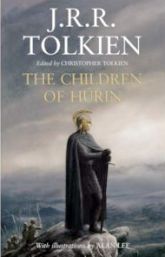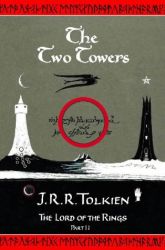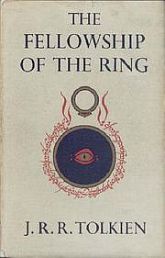“A darkness lies behind us, and out of it few tales have come,” says one character early in J.R.R. Tolkien’s The Children of Húrin. “…It may be that we fled from the fear of the Dark, only to find it here before us, and nowhere else to fly to but the Sea.”
 Sador is speaking here about the race of Men, and his statement may sum up Tolkien’s recently published novel as good as any. Children of Húrin is a tale about fear and Man’s futile attempts to wrest honor and courage from the jaws of certain doom. It’s a major new work, though incomplete, and one of the clearest distillations of Tolkien’s thought since the publication of The Silmarillion in the late ’70s.
Sador is speaking here about the race of Men, and his statement may sum up Tolkien’s recently published novel as good as any. Children of Húrin is a tale about fear and Man’s futile attempts to wrest honor and courage from the jaws of certain doom. It’s a major new work, though incomplete, and one of the clearest distillations of Tolkien’s thought since the publication of The Silmarillion in the late ’70s.
Those who have already read The Silmarillion will find a lot that’s familiar here. (For those who haven’t, be warned that there will be spoilers here.) The Children of Húrin is just an expanded version of the tale of Túrin Turambar, the longest (and best) chapter from that book. Having just recently read The Silmarillion myself, honestly this tale doesn’t seem all that different from the previously published version; fragments of the story also appeared in Unfinished Tales.
Technically, The Children of Húrin can be read as a stand-alone tale. It has a beginning and an ending, for the most part. But I imagine that readers who had trouble getting through The Silmarillion will have a difficult time understanding the context of what’s happening here. Who is this Morgoth, exactly? What’s all this about Fëanor and his sons? Christopher Tolkien does a rather poor job in the Introduction at summarizing the larger context of the story. We’re left with passages like this:
The second son of Finwë was Fingolfin (the half brother of Fëanor), who was held the overlord of all the Noldor; and he with his son Fingon ruled Hithlum, which lay to the north and west of the great chain of Ered Wethrin, the Mountains of Shadow. Fingolfin dwelt in Mithrim, by the great lake of that name, while Fingon held Dor-lómin in the south of Hithlum. Their chief fortress was Barad Eithel (the Tower of the Well)….
Or, more concisely stated, Yawwwwwwwwwwn.
So here’s basically what you need to know. Once upon a time the Valar (the gods) invited the immortal Elves to the land of Valinor in the West. There Fëanor, the smartest Elf in the pack, made three one-of-a-kind jewels called the Silmarils. But the evil god Morgoth stole them and took off to the land of Beleriand. Fëanor and many of his people went after him, rebelling against the Valar and taking an oath never to rest until the Silmarils had been recovered. The Elves established a bunch of kingdoms in Beleriand and have been fighting Morgoth for a few hundred years now (with the help of the Edain, the good Men).
But the tale of the Elves is really not as crucial in The Children of Húrin as that of Men. The main character of the book, Túrin son of Húrin, is a Man, after all. And the book revolves around this character’s noble, yet futile, attempts to rise to greatness.
It’s said in The Silmarillion that Elves are bound to the Earth. The Elves are immortal, and even when they die their souls sit in the halls of Mandos (a Hades of sorts) until they’re eventually resurrected. But Men have been granted the gift of death by Eru the One, their Creator. This means that Men’s souls leave the circles of the world when they die and go someplace that nobody, not even the Valar, know where.
 So there were all kinds of gems awaiting me on my re-reading of ROTK. I had completely forgotten about Beregond, Guard of the Citadel, and the heroic role he plays in saving Faramir from death at the hands of Denethor. I had only a faint recollection of Ghân-buri-Ghân and the Wild Men. I didn’t recall that our heroes have a run-in with Saruman before the Hobbits return to the Shire. I had forgotten that the only reason Merry was able to wound the Lord of the Nazgûl was because of his sword, picked up at the Barrow-downs in the early chapters of Fellowship.
So there were all kinds of gems awaiting me on my re-reading of ROTK. I had completely forgotten about Beregond, Guard of the Citadel, and the heroic role he plays in saving Faramir from death at the hands of Denethor. I had only a faint recollection of Ghân-buri-Ghân and the Wild Men. I didn’t recall that our heroes have a run-in with Saruman before the Hobbits return to the Shire. I had forgotten that the only reason Merry was able to wound the Lord of the Nazgûl was because of his sword, picked up at the Barrow-downs in the early chapters of Fellowship. It’s a difficult book. Frodo and Sam, the characters we’re most invested in, disappear for a couple hundred pages; Gandalf is presumably dead in the book’s opening chapters; Boromir’s definitely dead; and Aragorn is still something of a distant figure. Gimli is interesting enough but hardly crucial to the plot, and it’s difficult to give two figs about Legolas.
It’s a difficult book. Frodo and Sam, the characters we’re most invested in, disappear for a couple hundred pages; Gandalf is presumably dead in the book’s opening chapters; Boromir’s definitely dead; and Aragorn is still something of a distant figure. Gimli is interesting enough but hardly crucial to the plot, and it’s difficult to give two figs about Legolas. But more importantly, in an ideal world one would be able to discuss The Fellowship of the Ring without being overshadowed by Peter Jackson’s film of the same name. Unfortunately, for me that’s impossible. I’ve seen the films probably a dozen times each since their release, enough that I can recite most of the dialogue word for word. The Extended Edition of Fellowship is one of my favorite films ever, ever, ever.
But more importantly, in an ideal world one would be able to discuss The Fellowship of the Ring without being overshadowed by Peter Jackson’s film of the same name. Unfortunately, for me that’s impossible. I’ve seen the films probably a dozen times each since their release, enough that I can recite most of the dialogue word for word. The Extended Edition of Fellowship is one of my favorite films ever, ever, ever. If you’re going to read the complete works of Tolkien properly, you definitely should not follow The Silmarillion with The Hobbit. (
If you’re going to read the complete works of Tolkien properly, you definitely should not follow The Silmarillion with The Hobbit. (